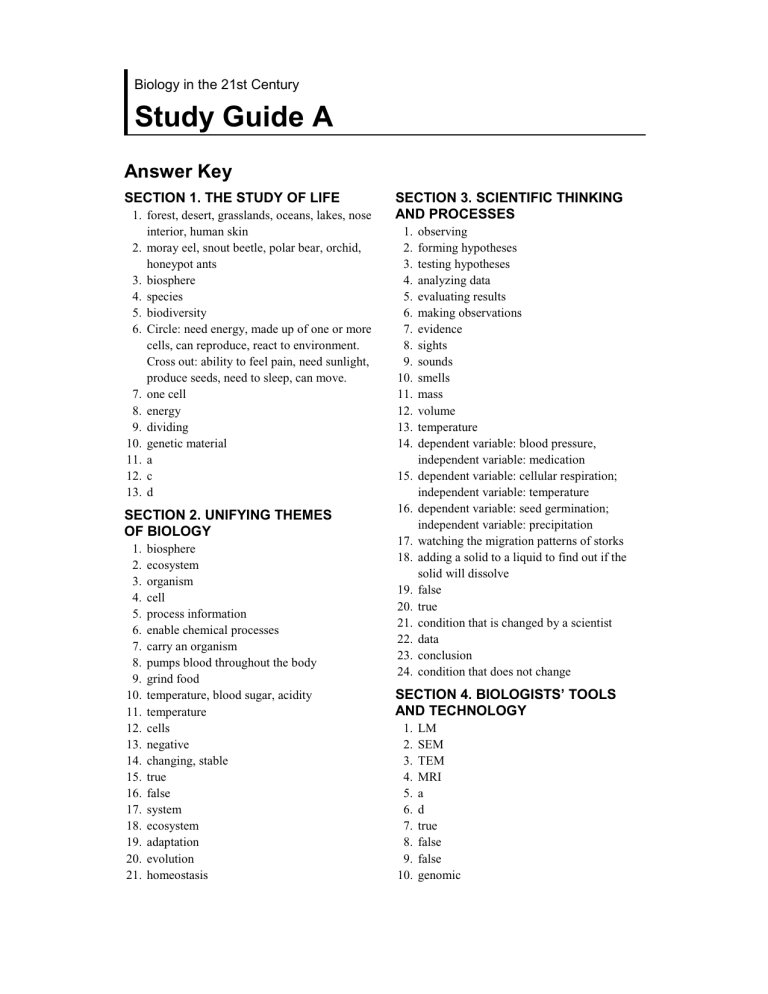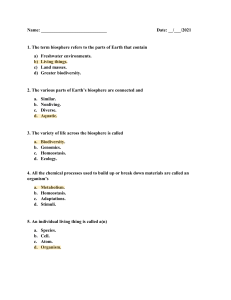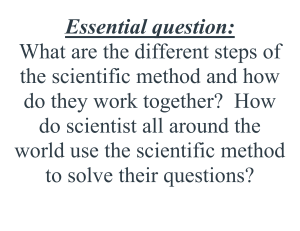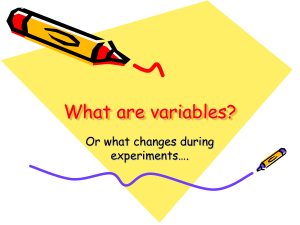
Biology in the 21st Century Study Guide A Answer Key SECTION 1. THE STUDY OF LIFE 1. forest, desert, grasslands, oceans, lakes, nose interior, human skin 2. moray eel, snout beetle, polar bear, orchid, honeypot ants 3. biosphere 4. species 5. biodiversity 6. Circle: need energy, made up of one or more cells, can reproduce, react to environment. Cross out: ability to feel pain, need sunlight, produce seeds, need to sleep, can move. 7. one cell 8. energy 9. dividing 10. genetic material 11. a 12. c 13. d SECTION 2. UNIFYING THEMES OF BIOLOGY 1. 2. 3. 4. 5. 6. 7. 8. 9. 10. 11. 12. 13. 14. 15. 16. 17. 18. 19. 20. 21. biosphere ecosystem organism cell process information enable chemical processes carry an organism pumps blood throughout the body grind food temperature, blood sugar, acidity temperature cells negative changing, stable true false system ecosystem adaptation evolution homeostasis SECTION 3. SCIENTIFIC THINKING AND PROCESSES 1. 2. 3. 4. 5. 6. 7. 8. 9. 10. 11. 12. 13. 14. 15. 16. 17. 18. 19. 20. 21. 22. 23. 24. observing forming hypotheses testing hypotheses analyzing data evaluating results making observations evidence sights sounds smells mass volume temperature dependent variable: blood pressure, independent variable: medication dependent variable: cellular respiration; independent variable: temperature dependent variable: seed germination; independent variable: precipitation watching the migration patterns of storks adding a solid to a liquid to find out if the solid will dissolve false true condition that is changed by a scientist data conclusion condition that does not change SECTION 4. BIOLOGISTS’ TOOLS AND TECHNOLOGY 1. 2. 3. 4. 5. 6. 7. 8. 9. 10. LM SEM TEM MRI a d true false false genomic Name: ___________________________ Hour: ____________ Pages 4-6 MAIN IDEA: Earth is home to an incredible diversity of life. forest polar bear snout beetle honey pot ants ocean lake human skin nose interior moray eel orchid desert grassland Use the phrases in the box above to fill in the chart below. 1. In the box labeled The Biosphere, list examples of environments on Earth in which life is found. 2. In the box labeled Species, list examples of species that can be found on Earth. Earth is home to an incredible diversity of life. The Biosphere Species Fill in the blank with the word or phrase that best completes the sentence. 3. The _____________ even includes places such as your eyelashes, pools of hot, acidic water in Yellowstone National Park, and cold, windswept rocks in the Aleutian Islands. 4. Members of a __________ should be able to reproduce together. 5. In places where ____________ is high, there are more species. MAIN IDEA: All organisms share certain characteristics. 6. In the box below, circle the four items that are characteristic of all living organisms. Cross out the items that are not characteristics of all living organisms. need energy need sunlight can reproduce made up of one or more cells produce seeds can move ability to feel pain need to sleep react to environment Using the words in the box, fill in the outline with the basic systems of life. more complex 1. _____________ 2. _____________ 3. _____________ 4. _____________ organism biosphere cell ecosystem less complex Match each body part with its specialized function. 5. brain cells carry an organism 6. enzymes process information 7. feet pumps blood throughout the body 8. heart enable chemical processes 9. teeth grind food Page 9 10. Circle the conditions that are regulated by homeostasis. temperature outside environment acidity thoughts blood sugar Circle the word or phrase that best completes the sentence. 11. Humans shiver in response to cold because of the body’s attempts to maintain an even temperature / acidity. 12. Homeostasis is important because behaviors / cells need certain conditions in order to function. 13. The body usually uses positive / negative feedback to maintain homeostasis. 14. The conditions outside the body are always the same / changing, but the conditions inside the body are generally very changeable / stable. Pages 7-10 Match the words with their meanings. 17. organized group of related parts that interact to form a whole evolution 18. physical environment with different species that interact with each other and with nonliving things adaptation 19. an inherited trait that gives an advantage to individual organisms and is passed on to future generations homeostasis 20. the change in living things over time ecosystem 21. the maintenance of constant internal conditions in an organism System Use the following words or phrases to fill in the blanks in the flow chart. (Page 15) forming hypotheses observing testing hypotheses evaluating results analyzing data Fill in the chart using the words from the box. 1. _______________ Scientists make observations and examine prior research. 5. _______________ Scientists evaluate data and conclusions presented by other scientists. 4. _______________ Scientists analyzes their data to draw conclusions about their research. 2. _______________ Scientists ask questions and try to explain observations. 3. _______________ Scientists collect data that they use to support or reject a hypothesis. Pages 13-17 sights volume temperature mass sounds smells Qualitative data Quantitative data 8. ___________________________ 9. ___________________________ 10. ___________________________ 11. ____________________________ 12. ____________________________ 13. ____________________________ Circle the dependent variable in each sentence. Draw a box around the independent variable. 14. A scientist is testing the effects of medication on the blood pressure of patients. 15. A scientist wants to find out how cellular respiration is affected by temperature. 16. A scientist is measuring the effect of precipitation on seed germination. Draw lines to match each type of investigation with an example. 17. Observational study Adding a solid to a liquid to find out if the solid will dissolve 18. Experiment Watching the migration patterns of white storks Draw lines to connect the phrases that mean the same thing. 19. independent variable conclusion 20. dependent variable condition that is changed by a scientist 21. theory data 22. constant condition that does not change Use the correct term from the box below to fill in the description with the correct type of technology. (pages 19-21) light microscope (LM) transmission electron microscope (TEM) magnetic resonance imaging (MRI) scanning electron microscope (SEM) 1. ___________________________ uses light and lenses to magnify images, can be used with living specimens, and can clearly magnify specimens up to about 1500 times. 2. ____________________________ uses electrons and computers to magnify specimens and produce three-dimensional images, cannot be used to observe living specimens, creates images that are computer colorized, and can clearly magnify specimens more than 100,000 times. 3. ____________________________ uses electrons and computers to magnify specimens and produce two-dimensional images, cannot be used to observe living specimens, creates images that are computer colorized, and can clearly magnify specimens more than 100,000 times. 4. _____________________________ uses strong magnetic fields to show a cross section of a body part and can show both soft tissues and dense tissues. Cross sections can be combined by computer to give a complete image of the whole area.





